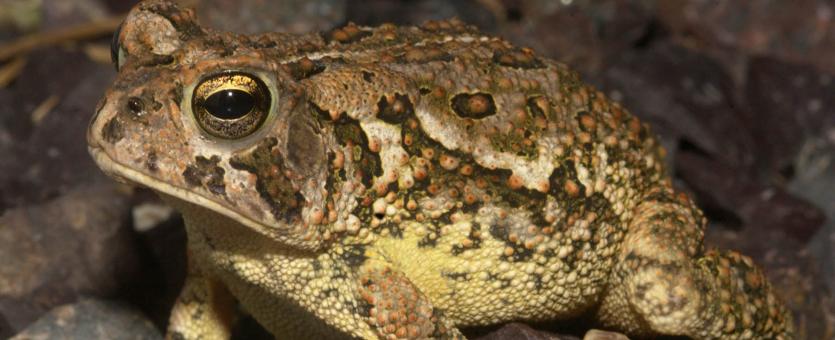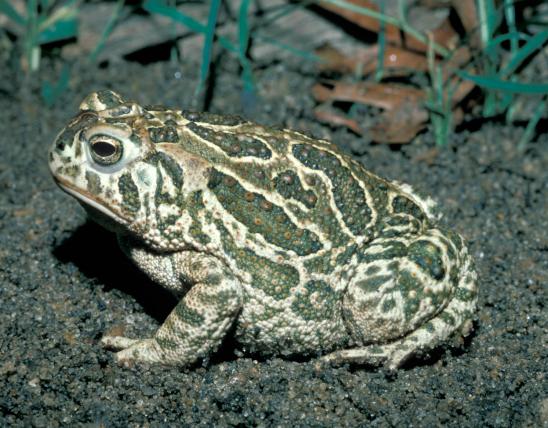
Fowler's toad is a medium-sized toad with a light gray to greenish-gray background color with 6 paired, irregular, dark gray spots on the back. There are also dark markings on the sides and legs. Each dark spot on the back generally has 3 or more "warts." There is usually a light tan or white line down the back. The belly is cream or white, and there is often a dark gray spot on the chest. The large, wartlike paratoid gland behind each eye is oblong and is connected to a rather shallow, bony cranial crest above each eye. The male's call is a short, medium-pitched, raspy, nasal “w-a-a-a-a-a-h,” lasting from 1 to 3 seconds.
Apparently, it hybridizes with the Rocky Mountain toad, in a zone from north-central to central and southwestern Missouri.
Similar species: Fowler’s toad used to be considered a subspecies of Woodhouse’s toad (Anaxyrus woodhousii), but genetic analysis and breeding call studies revealed they are distinct from each other. Missouri's subspecies of Woodhouse’s toad is the Rocky Mountain toad (A. woodhousii woodhousii).
In areas where their ranges overlap, Fowler’s toad probably hybridizes with the American toad (A. americanus) and the Rocky Mountain toad. Where this happens, intermediate characteristics will occur, making identifications tricky.
Members of the true toad family (Bufonidae) live nearly worldwide, except for New Zealand, Australia, Madagascar, and the polar regions. The family comprises 47 genera with more than 590 species. In the United States, there are 19 species of true toads, and all are members of the genus Anaxyrus. In Missouri, there are 4 species of true toads, with 1 additional subspecies.
True toads have dry skin compared to frogs. They have no teeth, lack extensive webbing on the hind feet, and have large, wartlike parotoid glands behind their eyes. Numerous “warts” over most of their bodies produce toxic skin secretions that are irritating to a predator’s mucous membranes.
Adult length (snout to vent): 2 to 3 inches; occasionally to nearly 4 inches.

In Missouri, occurs in northeastern, eastern, and southern portions of the state. Has a wide range in eastern North America.
Habitat and Conservation
Fowler’s toads occur in a wide variety of habitats, especially open areas with loose or sandy soils. This is the common toad of gravel and sand bars along Missouri’s many Ozark streams and rivers, as well as the sandy areas in the Mississippi Alluvial Basin in the Bootheel. They are also seen in open wooded areas, urban and suburban yards, fields, and gardens.
As with other toads, this amphibian remains hidden in burrows by day, becoming active at night to hunt. All of Missouri’s species of true toads are primarily nocturnal, seeking shelter during the day among piles of dead leaves, under rocks and logs, or in loose soil.
Food
This toad feeds, mostly at night, on a variety of insects and earthworms.
As a family, toads are well-known for their consumption of large numbers of insects. During summer nights, toads often catch and eat insects as they fall to the ground under outdoor lights.
Status
This is the common toad of gravel and sand bars along Missouri's Ozark streams and rivers and in sandy areas of the Bootheel lowlands.
Life Cycle
In southern Missouri, the species begins to breed in late March into April and May. In the rest of the state, breeding begins in May or early June. They select flooded fields, ditches, swamps, marshes, and shallow, slow-water sections of streams, as well as ponds on occasions. Females are attracted to the breeding sites by a chorus of calling males. A female may lay over 8,000 eggs. The tadpoles usually hatch in less than a week. Toadlets start transforming in 21 to 60 days and begin appearing in late June through mid-July. It takes them one to two years to reach maturity.
Human Connections
What would a gorgeous night camping on an Ozark river sandbar be, without nature’s symphony of sounds: the lapping of the water, the rasps and chirps of innumerable insects, the calls of whip-poor-wills . . . and the “wa-a-a-a-h” calls of Fowler’s toads?
Contrary to superstition, toads do not cause warts on humans.
The species was first described in 1882 by Massachusetts herpetologist Mary H. Hinckley. The name she gave it, fowleri, or "Mr. Fowler's Toad," honors the naturalist Samuel P. Fowler (1800–1888). A native of Essex County, Massachusetts, he was a steadfast promoter of his county's natural history society, and he published extensively on the subject of the New England Puritan witchcraft trials.
Ecosystem Connections
Like other small amphibians, this toad provides food for several species of predators, including birds, snakes, fish, and mammals. As a hunter itself, this toad checks the populations of many insect species.
































